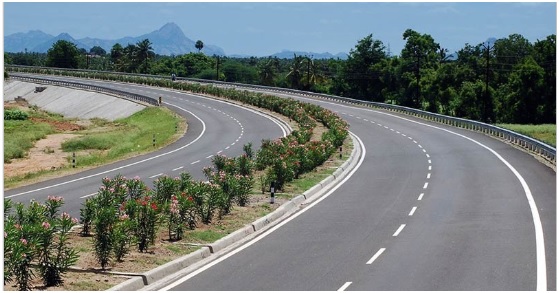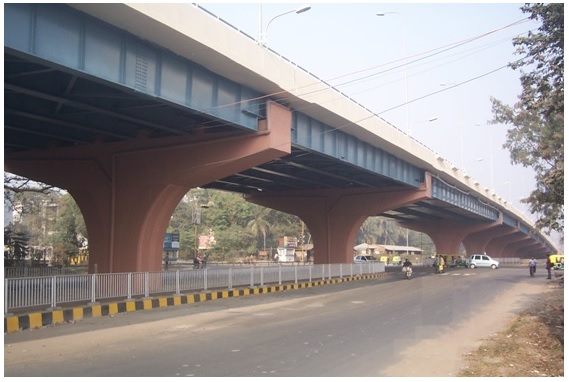Highway engineering is a discipline branching from Civil Engineering that involves the planning, design, construction, operation, and maintenance of Roads, bridges, Structures and Tunnels to ensure safe and effective Transportation of people and goods. Highway engineering became prominent towards the latter half of the 20th Century after World War II. Standards of Highway Engineering are continuously being improved. Highway engineers are to take into account future traffic flows, capacity of signalized intersections, design of highway intersections/interchanges, geometric alignment and design, highway pavement materials and design, structural design of pavement thickness, and pavement maintenance.
The facets of Civil Engineering to participate:
• Transport Engineering (Masters Programme)
• Highway Engineering (Bachelors & Masters)
• Survey and Geodesy (Bachelors)
• Bridge / Structural Engineering (Bachelors & Masters)
• Geotechnical Engineering (Bachelors & Masters)
• Pavement Engineering (Bachelors & Masters)
• Hydraulics Engineering (Masters Programme)
• Bill of Quantities /Rate Analysis/ Cost Estimation (Bachelors)
For “Capacity Building” of engineers and professionals in various states across the country, it is important to impart training to them in the areas of Procurement of Consultants for Feasibility Studies, Determine Economic Internal Rate of Return, Project Viability, Deciding and Obtaining Project Funding Preparing of Detail Engineering and hence the Detail project Report (DPR), Preparing of Bid Documents for e-tendering, Tender Evaluation, Procurement of EPC (Engineering-Procuring-Construction) Contractors or BOT Concessionaires, Procuring Supervision Consultants, Construction Management, Operation and Maintenance.
In this web site the Tutorials are provided for Training to engineers and professionals for doing and reviewing tasks in the phases of development of Feasibility Studies, Determine Economic Internal Rate of Return, Project Viability, Deciding and Obtaining Project Funding Preparing of Detail Engineering and hence the Detail project Report (DPR), Preparing of Bid Documents for e-tendering. These Tutorials are must for all engineers and professionals working for Transport Engineering projects all over the world. For such training in capacity building the usage of appropriate software tools are highly essential and must be competent to provide all necessary facilities to carry out the various jobs with expected accuracy and technical standard having simplest operational procedures. The various chosen software along with Tutorials for the training are described below with their technical features.
Tutorials for Highway Engineering and Design
Tutorials for book “Computer Aided Highway Engineering” Published by CRC Press of Taylor and Francis are made by using versatile highway design software HEADS Pro. The tutorials with Step by Step guide are available for download from this web site for practicing the tutorials of the above book and also for mastering the software HEADS Pro.

Most of the current projects are widening of 2/4 Lane Highways to 4/6/8 Lane Expressways, where the existing road is strengthened with pavement overlay and widened with new construction on the side. Along the alignment of the route the side of widening changes its pattern from left to concentric to right. In PPP / BOT mode projects, there are requirements for route Re-alignments, Bye-passes, Vehicular / Pedestrian Underpasses, Elevated Flyovers, Service roads, Bus Bays, Truck Lay Byes, Rail over bridges, box pushed Rail/Road underpasses, Toll Plaza etc. These make the design quite complex and are done in parts by various market available software products.
HEADS Pro is capable of producing the design & estimation for the entire route with varying configuration in one go with automatic sheet layout to create best quality sophisticated PLAN-PROFILE-CROSS SECTION drawings in CAD form for construction, this saves design time substantially.
HEADS Pro uses Hi-Tech facilities like Satellite/Google Earth based alignment design for 4/6/8 Lane National/Federal Highway or Expressway projects, GPS instrument based alignment design which is very useful for Hill road projects, processing for Digital Terrain Model (DTM) by using downloaded Ground Topography data from internet with Shuttle Radar Topography Mission (SRTM, may be by using Global Mapper) and without carrying out any field Survey and so on, all these utilize the latest features available with advent of internet & satellite technology. This also saves design time substantially.
HEADS Pro is thus the best tool for the Design of Highway, Multi lane & Multiple section Expressways, Highway widening and Low Cost Rural Roads.
HEADS Pro has special techniques for the design of Hill Roads requiring extra widening at curves and by using Bearing Line data, Slopes varying with depth of cut, Providing Gabion walls on cut side and Retaining walls on fill side by interface analysis.
HEADS Pro also features for design of Tunnels, Pavements, Drainage by producing construction drawings and Bill of Quantities. It uses Topo-survey data from Total Station, Auto Level, GPS, downloaded from Internet (SRTM) etc. and are best processed to create the Digital Terrain Model (DTM) by triangulation and ground contours. The users get full satisfaction by getting a technical environment which is complete with the latest advanced technology.
HEADS Pro features for the design of At Grade Traffic Intersections and Multi level Grade Separated Interchanges with CAD based Intersection Type selection and insertion in the Highway Design with Swept Path Analysis for observing speed limits in Ramps, Loops and Slip Roads.
HEADS Pro has special module for Car Racing Track Design with Closed Traverse and Concave Parabolic Carriageway Cross Section.
HEADS Pro has the powerful Tunnel module for the design of Vehicular Tunnels by using Trimble ‘S’ Series Robotic Total Station scan survey data for Bored Tunnels. The occurrences of Tunnels along the route of the highways are very common in most of the National/Federal Highway projects and the engineers must be provided with the best and simple design procedure in 3 Dimensional in-built CAD system.
HEADS Pro has facilities for automatic alignment and profile design with profile optimization based on requirements of Pavement structure, Profile Correction and design overlay thickness.
HEADS Pro has full range of Flexible & Rigid pavement design facilities in AASHTO & IRC Standard also for low cost rural roads. It also features for Asphalt/Bituminous Mix Design for AC/BC, SDBC, DBM, BM for Quality Control at Construction Site.
HEADS Pro supports road pavement rehabilitation by using various Fiber glass ‘Geogrids’ or Geotextiles and by obtaining the result on strength improvement given by detail step wise report. Strengthening of wearing course of Bituminous Pavement by using Geo Synthetics may be done by determining strength of various products for applied traffic load by using Layered System Analysis, The design of pavement overlay may be done with statistical analysis of Benkelman Beam Deflection test data with temperature and seasonal corrections.
HEADS Pro has provisions for maintenance of Land Acquisition records by inter-connecting Land maps as CAD drawings and Land records in Microsoft ACCESS Database Management System coupled with MS Excel. The process is very simple and useful in various highway development projects.
HEADS Pro Tutorial Videos are available in YouTube to understand the various design processes.
For some Highway Design Tutorial Videos in ‘YouTube’ please use the link below:
https://www.youtube.com/playlist?list=PLdAsx5BM1YXRjSy7LUeKM6XBdqZSG5gMq
For various other Tutorial Videos in ‘YouTube’ please use the link below:
https://www.youtube.com/channel/
UCLY751jDWngqMfhKrlRcVwA/playlists
Tutorials for Bridge Engineering and Design

Tutorials for book “Computer Aided Bridge Engineering” are made by using versatile Bridge design software ASTRA Pro. The tutorials with Step by Step guide are available for download from this web site for practicing the tutorials of the above book and also for mastering the software ASTRA Pro.
ASTRA Pro operates in Standards of AASHTO-LRFD, BS 5400, Eurocode2, BS 8006, BD 37/01, and IRC 112, 114 & IRC 6. The designs are in Working Stress (IRC & British Standard) and in Limit State (AASHTO, BS Eurocode2 and IRC) as well.
ASTRA Pro is the software for Engineering Design of Bridges carrying Normal, Stage and Orthotropic analysis with Dead Load, Superimposed Dead Load, Moving Vehicle Live Load Classes (AASHTO LRFD/BS BD 37/01, IRC).
ASTRA Pro has three suits, these are Bridge Design, Structure Design and Structural analysis all are with CAD based Graphical User Interface, Bridge design uses the Grillage Model for analysis of Deck-Girder superstructure using beam and boundary elements selecting from Finite Element library.
ASTRA Pro bridge design suit includes the design of RCC T-Girder Bridges, Composite Bridges with Steel Plate/Box Girder and RCC Deck Slab in straight or curved layout with single or Multi-Span configuration, PSC I-Girder Bridges, PSC Box Girder Bridges, Continuous PSC Box Girder Bridges, various Steel Truss Bridges, Arch Suspension Bridges, Rope Cable Suspension Bridge, Cable Stayed & Extradosed River Bridges with non-linear Stage Analysis, Flyovers, Rail/Road Over Bridges, Vehicular/Pedestrian Rail / Road Underpasses as RCC Box, RCC Box Culverts (Single Cell & Multi Cell), RCC Slab Culverts, NP3/NP4 Pipe Culverts, Stream Hydrology, RCC Pier and Wall & Box type Abutment with Front and Back Counter fort Earth Retaining walls, with analysis in span lodged and dislodged conditions and seismic analysis, Well, Pile and Open Foundations, Bridge Bearings, Estimation for BoQ and Cost with item Rate Analysis.
ASTRA Pro Structural Design suit has applications for RCC Framed Multi Storied Buildings with Foundation options for Open-Pile-Raft, RCC Tunnel Lining with Shotcrete, Steel Ribs and RCC Portal based on Rock Quality Designation (RQD) and Rock Mass Rating (RMR), RCC Retaining Wall, Reinforced Earth Wall (BS 8006), RCC & PSC Jetty design, Steel Towers/Pilons etc.
ASTRA Pro Structure Analysis suit features for Finite Element Models by Beam, Truss, Plate/Shell, Solid Brick and Boundary Elements acted on by Static, Dynamic, Temperature, Sinking Support, Moving vehicle Loads. Full set of examples are given to facilitate user with CAD workspace based model generation and analysis, for example Dynamic analysis of Block-type machine foundation by creating model with 3d-Solid brick elements. The Dynamic Analysis is carried out for Eigen Values, Response Spectrum and Time History Analysis. Analysis is supported by Pre and Post processors with CAD Graphical User Interface to view while creating 3D model for structure and analysis data. The structural analysis suit is powered by SAP engine by University of California, Berkley, USA.
ASTRA Pro gives the complete Analysis and Design report with details in step wise format and complete set of sample construction drawings in editable CAD format. In the Unauthorized version the default input data cannot be changed and the drawings are for viewing only. The Reports and drawings are complete as a set for each design modules. Detail estimation for BoQ, Item Rates & Cost are also available for Girder type Bridges, Box type Bridges/Culverts and Composite bridges.
ASTRA Pro Installation Setup and Tutorials are available for download from this web or from web site www.techsoftglobal.com, The various Tutorial Videos on Structural Analysis & Design by ASTRA Pro are available on "Youtube" by searching for "TECHSOFT FORUM".
For some Bridge Design Tutorial Videos in ‘YouTube’ please use the link below:
https://www.youtube.com/watch?v=rEbkYmPVeUg&list=PLdAsx5BM1YXSJwo_2-aYU51Tpu-qDbPa3
You may also use the links:
Bridge Design Tutorial Videos with ASTRA Pro: https://bit.ly/37wayih
Structure Analysis and Design with ASTRA Pro: https://bit.ly/35x9Ak0
Tutorials for Traffic Analysis and Transport Planning

Tutorials for Traffic Analysis and Transport Planning are available by using versatile Transport Planning software TransPlan. The tutorials with Step by Step guide are available for download from this web site for practicing the tutorials of the above book and also for mastering the software TransPlan.
Road improvements that reduce users’ travel costs tend to attract traffic from other routes, times and modes, and encourage longer and more frequent vehicle trips. This is called generated traffic, referring to increased vehicle traffic volumes at a particular time and location, including travel diverted from other times and routes. A portion of this additional traffic usually consists of induced travel, referring to increases in total vehicle trips and distance traveled, excluding diverted traffic. Induced travel is therefore a subcategory of generated traffic.
This additional traffic reflects the economic “law of demand,” which states that consumption of a good usually increases as its price (consumers’ perceived costs) declines, all else being equal. Reducing congestion reduces the generalized cost of driving, thus encouraging more peak-period vehicle travel. To put this another way, most congested roads have latent travel demand : additional peak-period vehicle trips that will occur if congestion is relieved.
The on-site traffic count, at mid-block in a selected homogeneous section and turnings, for classified tollable and non-tollable vehicles are estimated separately and present average daily traffic (ADT) is evaluated. The variations in volume of traffic during various seasons in the year with fuel selling records are also included in the studies. Next projected traffic is estimated over the analysis period, with Annual Average Daily Traffic (AADT). The estimated revenue generation over the analysis period and the cost of construction with routine and periodic maintenance will be used for economic and financial analysis to study the viability.
The premium software TransPlan features for Dialog Box and MS-Excel Worksheet based Traffic Analysis and Transport Planning with Tables and Graphical Charts. The software TransPlan is available with very high academic and technological standard for carrying out various work related to traffic analysis and transport planning for any highway Feasibility and DPR projects.
TransPlan features for signalized intersection capacity analysis as per Highway Capacity Manual (HCM) by Transportation Research Board, Traffic Analysis to obtain Peak Hour Factor, Seasonal Variation Factor, Traffic Homogeneous Sections, Toll-able Traffic, Average Daily Traffic (ADT), Annual Average Daily Traffic (AADT), Transport Demand Elasticity, Traffic Projections, Capacity and Level of Service (LOS), Equivalent Standard Axle Load (ESAL/MSA), Economic Analysis and Financial Analysis for a highway project.
TransPlan essentially also features for computation of Toll Rates and provides Toolkit with guide for Road Asset Management.
Tutorials for Signalized Intersection Capacity Analysis

Tutorials for determining Signalized Intersection capacity are available by using versatile software SICap. The tutorials with Step by Step guide are given in the User’s Manual available for download from this web site for practicing the tutorials of the above book and also for mastering the software SICap. The program SICap is based on Highway Capacity Manual (HCM) by Transportation Research Board (TRB), Washington D.C. The program SICap is also included as ‘in-built’ in software TransPlan.
